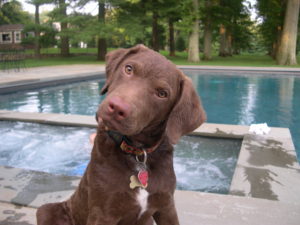![]()
quick bites
Training

Training 101:
- Reward the behaviors you like, and they will increase.
- Interrupt (nicely!) the behaviors you don’t like, and they will decrease.
- Redirect your dog to a behavior incompatible with the unwanted behavior.
- Prevent naughty behaviors by managing your dog’s environment.
MAKE THE RIGHT BEHAVIOR EASY AND THE WRONG BEHAVIOR DIFFICULT.
Give your dog clear instructions – verbal and visual – so he understands the right behavior. Think of the goal you want your dog to reach and break it up into small steps. If you reward each successive step, your dog will reach the goal much faster. Avoid distractions when you’re teaching a new behavior, so your dog can focus. And prevent access to things that encourage wrong behaviors.

Don’t assume your dog knows something if you haven’t taught him.
Your dog wasn’t born knowing your rules, nor what humans consider ‘acceptable’ behavior. Your dog doesn’t purposely misbehave and isn’t being spiteful when he performs an inappropriate behavior, especially for attention. In fact, your dog wants to please you. Help your dog learn good manners by teaching him what’s acceptable and unacceptable to you and your family. Just as your dog doesn’t purposely misbehave, he doesn’t know that he’s doing something right unless you tell him.
Treats to Train.
Food is a primal need and training with food builds an intense bond and a strong foundation. In most cases, using food treats is the fastest way to teach a dog to do anything. Treats provide an easy, and fun way to communicate what you want and reward your dog for a job well done.
Teach, don’t punish.
Dogs, like children, can’t learn if they’re afraid. In most cases, punishment causes fear and harm and can lead to aggressive behavior. Punishment can cause dogs to develop a negative association with the person implementing the punishment or the environment where it occurs. Even the most experienced trainers find it difficult to (1) precisely time the punishment so that the dog understands what he did wrong, and (2) use the proper intensity that works, without harming the dog. Positive reward-based training is the safest and fastest way to teach your dog what you want him to do and not to do.
Housetraining 101:
- Teach your dog where to relieve himself outside; praise and reward to reinforce his good behavior.
- Provide ample opportunity to eliminate outside. (Think how stressful it would be if someone locked you out of your bathroom!)
- Actively Supervise inside while your dog is still learning. It could take weeks or months depending on your dog.
Note: If your dog has an accident inside, don’t blame or punish him as that could make him confused or afraid of you. Instead, consider that you may have missed one or more of the points above, or that your dog has a medical condition that requires a visit to your vet.
Leash Walking 101:
Think of leash walking as holding hands with your dog. The goal is to walk side-by-side on a loose leash without any tension. For this to happen, you must:
- Teach your dog that pulling doesn’t work.
- Refrain from pulling your dog. Dogs have an opposition reflex which means that they reflexively pull away from tugs on their leash.
Manners 101:
Teach your dog that Sit = Please. Ask your dog to “sit” before you give him meals, treats, toys, greetings, rides in the car and playtime. Your dog will quickly pattern that behavior and sit as a way of saying “please” for the things he wants in life.
